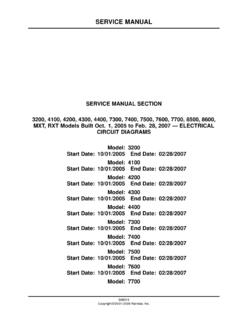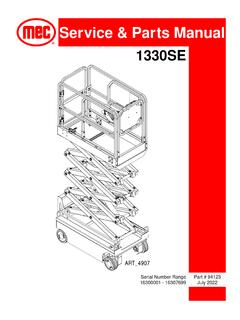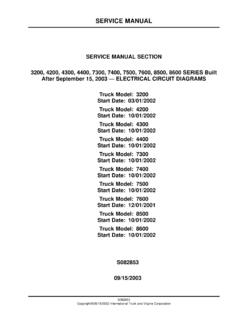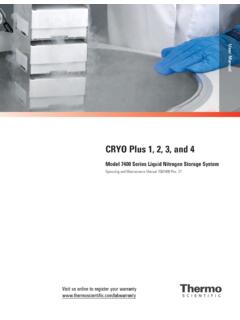Transcription of Range Rover Electrical Library - LM - 2nd Edition - Eng
1 Electrical LibraryNRRERL 28/11/01 10:02 am Page 1 Electrical LIBRARYLRL 0453 ENG(2)Published by Land Rover Land Rover 2002 All rights reserved. No part of this publication may be reproduced, stored in a retrieval system or transmitted in any form, electronic, mechanical, recording or other means without prior written permission from Land Rover 1 INTRODUCTION .. 1 ABOUT THIS DOCUMENT .. PRECAUTIONS .. TO USE THIS DOCUMENT .. DIAGNOSIS .. COLOUR CODES .. DETAILS .. 2 ENGINE COMPARTMENT FUSE BOX .. COMPARTMENT FUSE BOX .. FUSE BOX .. POINTS AND HEADERS .. 3 DESCRIPTION AND OPERATION .. 4 ANTI-THEFT ALARM AND CENTRAL DOOR LOCKING (CDL) .. IMMOBILISATION .. MIRRORS .. MIRROR .. SEATS .. HEATED SEATS .. HEATED SEATS.
2 SOCKET .. AND CHARGING Td6 .. AND CHARGING V8 .. CONTROL .. AUTOMATIC TRANSMISSION (EAT) GM5 .. AUTOMATIC TRANSMISSION (EAT) ZF .. BRAKING SYSTEM (ABS) .. RESTRAINT SYSTEM (SRS) .. TEMPERATURE CONTROL (ATC) .. TEMPERATURE CONTROL (ATC) COMFORT .. BURNING HEATER Td6 .. BURNING HEATER V8 .. FAN .. REAR WINDOW (HRW) .. ROVERHEATED FRONT SCREEN (HFS) .. AND WASHERS .. WASH/WIPE .. AND REVERSE LAMPS .. , SIDE AND TAIL LAMPS .. HEADLAMP LEVELLING .. LAMPS .. INDICATOR/HAZARD WARNING LAMPS .. LAMPS .. ILLUMINATION .. LIGHTERS .. SOCKETS .. SOCKET .. SYSTEM LOW LINE .. SYSTEM MID-LINE .. SYSTEM HIGH LINE .. NAVIGATION SYSTEM .. NAVIGATION SYSTEM NAS .. HANDS FREE.
3 NAS .. PUMP .. COUPLER .. DISTANCE CONTROL (PDC) .. PRESSURE MONITORING (TPM) .. COLUMN .. 4114 AIR SUSPENSION .. 5 CIRCUIT REFERENCE NUMBERS .. Rover THIS DOCUMENTG eneralThis document is intended to assist in diagnosing Electrical faults, and should be used in conjunction with the Electrical Circuit Diagrams. The document is divided into the following Includes Electrical Precautions, a list of Abbreviations and general information on how to use this DETAILS Provides details of location, rating in Amperes, and circuit(s) POINTS AND HEADERS Provides details of earth points and earth headers, including a plan view of the vehicle to aid AND OPERATION Provides an explanation of how each of the systems REFERENCE NUMBERS Provides a list of circuit reference numbers against a model or feature to which they DETAIL Details of connectors including a location photograph, face view and pin-out.
4 Before starting Electrical checks on the vehicle, ensure that relevant mechanical functions operate to the LH or RH side given in this document are made when viewing the vehicle from the covered in this document do not include reference to testing the vehicle after repair. It is essential that work is inspected and tested after completion and, if necessary, a road test of the vehicle is undertaken, particularly where safety related items are : Before undertaking any Electrical work on a vehicle ALWAYS read the Electrical ROVERB attery VoltageOpen Circuit Voltage TestBefore commencing diagnosis of Electrical problems, verify the condition of the battery is acceptable by using the open circuit voltage Switch off all Electrical loads on the Adjust digital multimeter to read dc volts on the appropriate Connect test probes across battery terminals ensuring that polarity is correct and record the voltage reading of V or more is acceptable.
5 Any battery which reads less than this will need : If the vehicle has been used within a period of 8 hours prior to the test, surface charge must be removed from the battery by switching the headlamps on for approximately 30 seconds. Wait a further 60 seconds before checking the open circuit voltage is used as a known reference for ascertaining whether or not circuits are receiving sufficiently high voltage for components to function correctly. This reference is only a guide since most electronic circuits are designed to function over a wide Range of voltages. In addition, consideration must be given to readings affected by voltage drop across certain components and fluctuations due to cable Rover PRECAUTIONSG eneralThe following guidelines are intended to ensure the safety of the operator whilst preventing damage to the Electrical and electronic components fitted to the vehicle.
6 Where necessary, specific precautions are detailed in the relevant sections of this document, reference to these precautions should be made prior to commencing repair Prior to commencing any test procedure on the vehicle, ensure that the relevant test equipment is working correctly and any harnesses or connections are in good condition. This particularly applies to mains lead or : Before commencing work on an ignition system, all high tension terminals, adaptors and diagnostic equipment for testing should be inspected to ensure that they are adequately insulated and shielded to prevent accidental personal contact and to minimise the risk of shock. Wearers of surgically implanted pacemaker devices should not work in close proximity to ignition circuits or diagnostic Never reverse connect the vehicle battery and always observe correct polarity when connecting test Voltage Circuits Whenever disconnecting live ht circuits, always use insulated pliers and never allow the open end of the ht lead to come into contact with other components, particularly ECU's.
7 Since high voltage spikes can occur on the terminals of the coil while the engine is running, exercise caution when measuring the voltage at these : The Xenon headlamp system generates up to 28,000 V and contact with this voltage could lead to fatality. Make sure that the headlamps are switched off before working on the system. Refer to the guidelines given in the 'General Information' section of the Service Repair Procedures Workshop manual before any work is carried and Harnesses The engine compartment of a vehicle is a particularly hostile environment for Electrical components and connectors. Always ensure these items are dry and oil free before disconnecting and connecting test equipment. Never force connectors apart either by using tools or by pulling on the wiring harness.
8 Always ensure locking tabs are disengaged before removal and note orientation to enable correct reconnection. Ensure that any protective covers and substances are replaced if ROVERB efore removing a faulty component, refer to the Workshop manual for removal procedures. Ensure the ignition switch is turned to the 'OFF' position, the battery is disconnected (see Battery Disconnecting) and any disconnected harnesses are supported to avoid any undue strain at the terminals. When replacing the component keep oily hands away from Electrical connection areas and push connectors home until any locking tabs fully DisconnectingIt is imperative that the key is removed from the ignition switch before disconnecting the battery. A time of 2 minutes must also elapse (after the ignition has been switched off) before the battery should be disconnected.
9 Failure to do so could result in:lNavigation computer software damagelIncorrect fuel gauge disconnecting the battery, disable the alarm system and switch off all Electrical equipment. If the radio is to be serviced, ensure the security code has been : Never disconnect the battery with the ignition switched : To prevent damage to the navigation computer software, a waiting period of two minutes must elapse after the ignition is switched off before the battery leads are : To prevent damage to Electrical components, always disconnect the battery when working on the vehicle's Electrical system. The earth lead must be disconnected first and reconnected : Always ensure that battery leads are routed correctly and are not close to any potential chafing reconnecting the battery, the steering wheel must be turned to full LH and RH lock (with the engine running).
10 This allows the Dynamic Stability Control (DSC) system to relearn the steering wheel position. Failure to do so will result in a variety of instrument pack warning lamps being Rover ChargingOnly recharge the battery with it removed from the vehicle. Always ensure any battery charging area is well ventilated and that every precaution is taken to avoid naked flames and New Range Rover is fitted with a lead calcium battery, and can only be charged using equipment specifically designed to operate on this type of battery. Refer to the Land Rover Equipment bulletin for a list of recommended battery charging off ignition prior to making any connection or disconnection in the system as Electrical surge caused by disconnecting 'live' connections can damage Electrical hands and work surfaces are clean and free of grease, swarf, etc.



